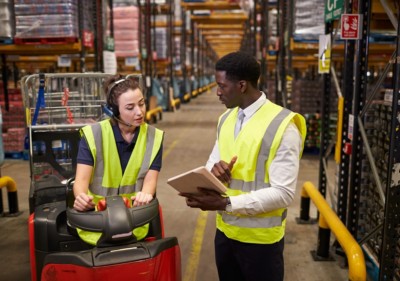Home / Racking and Shelving Insights / Common Hazards to Avoid in the Warehouse
 Many organisations have standard safety operating procedures, but to say there is only one way to ensure warehouse safety would be folly. However, there are certain principles that can and should be applied to minimise safety risks within a warehouse.
Many organisations have standard safety operating procedures, but to say there is only one way to ensure warehouse safety would be folly. However, there are certain principles that can and should be applied to minimise safety risks within a warehouse.
To help you stay on top of safety management practices, here are common warehouse safety risks and the actions needed to ensure a safe working environment:
Back strain is a common occurrence among warehouse staff, making up almost 20 per cent of all workplace injuries. A back injury usually happens when workers underestimate the weight of an object when lifting, or by mishandling heavy equipment. Back injuries reduce productivity and increase spending on medical claims; chronic back problems occasionally lead to a permanent loss of staff.
The solution: encourage your staff to practise the proper lifting techniques, such as bending the knees, keeping a straight back and transferring the weight through the legs rather than bending over to lift. Store objects at a height that does not require employees to stoop to pick them up, and place work surfaces at a sufficient height. Time spent educating your staff on how to use lifting equipment will prevent accidents in the future.
Fires can devastate a business. Although the major concern is for the safety of staff, fires can result in a major loss of inventory, property damage and an indefinite company shut down for repairs. Many warehouse fires are caused by open flames, fluorescent light sparks, fuel leaks and malfunctioning electrical equipment.
The solution: follow government guidelines. The New Zealand government’s Worksafe website provides details for fire precautions in transport, warehouse and postal services. The government also provides strict legislation and fire safety standards. Basic suggestions include fire drills and safety training to familiarise staff with fire extinguishers, assembly points and exits. Store flammable products in a storage unit designed for hazardous goods. Check that the warehouse complies with fire prevention regulations and has adequate equipment to put out fires − whether it be fire blankets and hoses or a high-volume sprinkler system.
Trips, slips and falls in a warehouse usually occur due to untidy, unorganised work areas. Throughout the day, desks and work areas become cluttered with, for example, packaging and tools. Workers forget or don’t bother to clean up after their work and don’t store equipment properly after use. These habits pose ergonomic issues and cause serious safety hazards.
The solution: assign separate areas for loading, sorting and storing. Have waste disposal skips stationed nearby for discarded packaging. Place non-slip mats in areas where spills usually occur. Ensure all your equipment has a designated storage space and that workers return them after work.
It is important that storage and handling systems meet your complex requirements. At Shelving Shop Group, we offer warehouse safety audit services. We perform safety checks and maintenance assessments, ensuring the safety and quality of your storage systems.
Our goal is to help you maintain an organised and safe work environment. Warehouse efficiency is at the heart of our business. Call us now on 0800 180 280 and schedule an inspection with us.